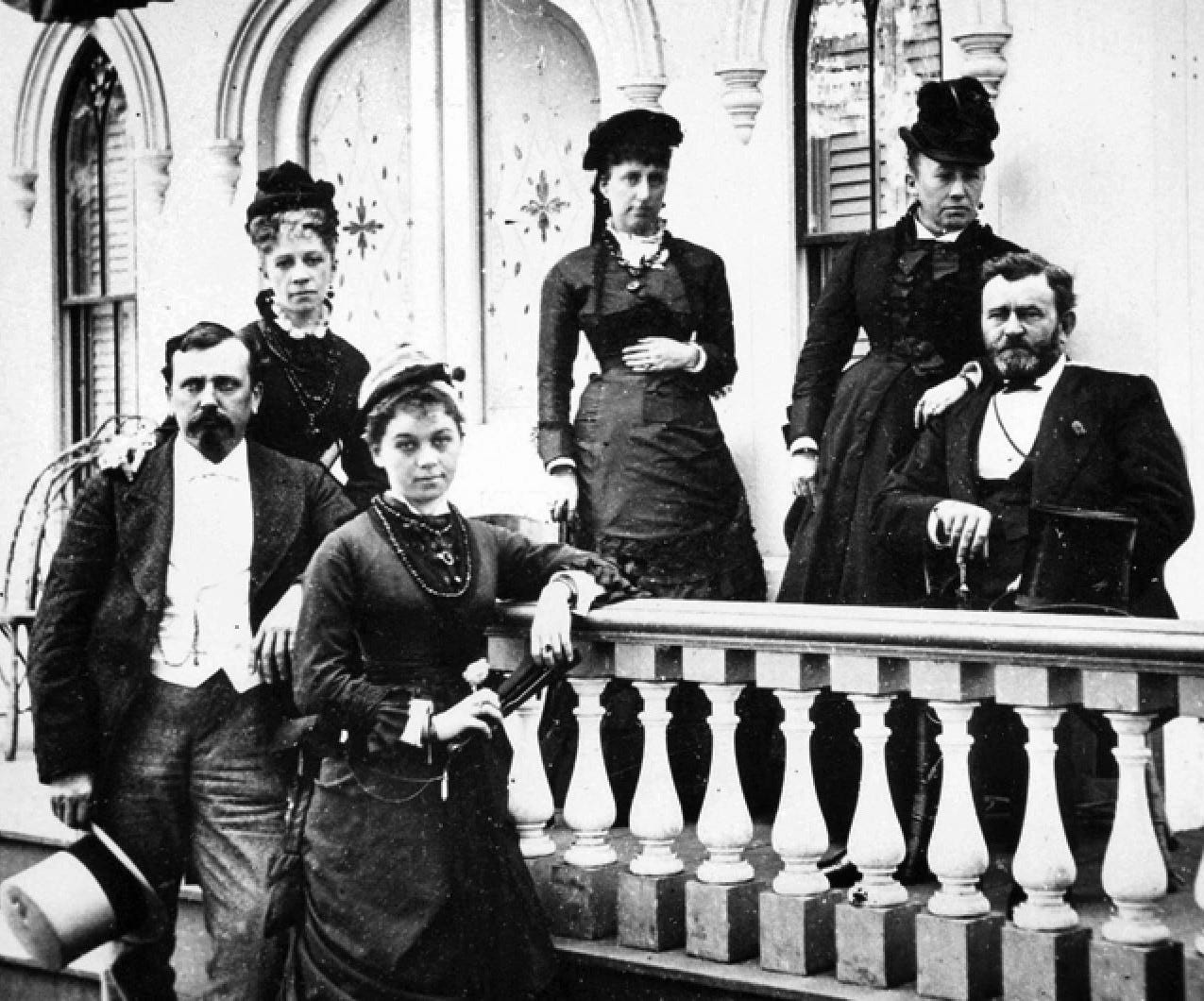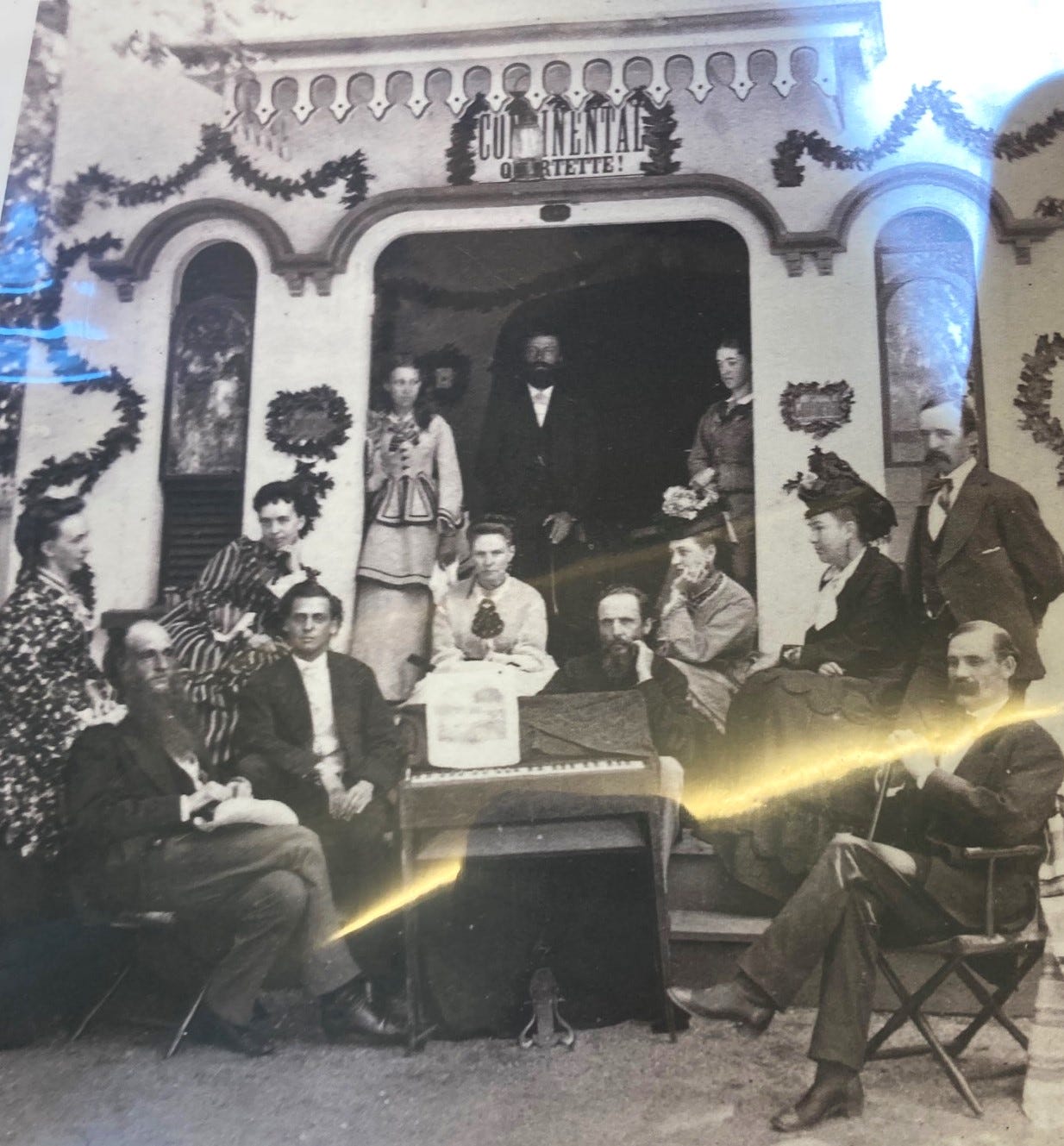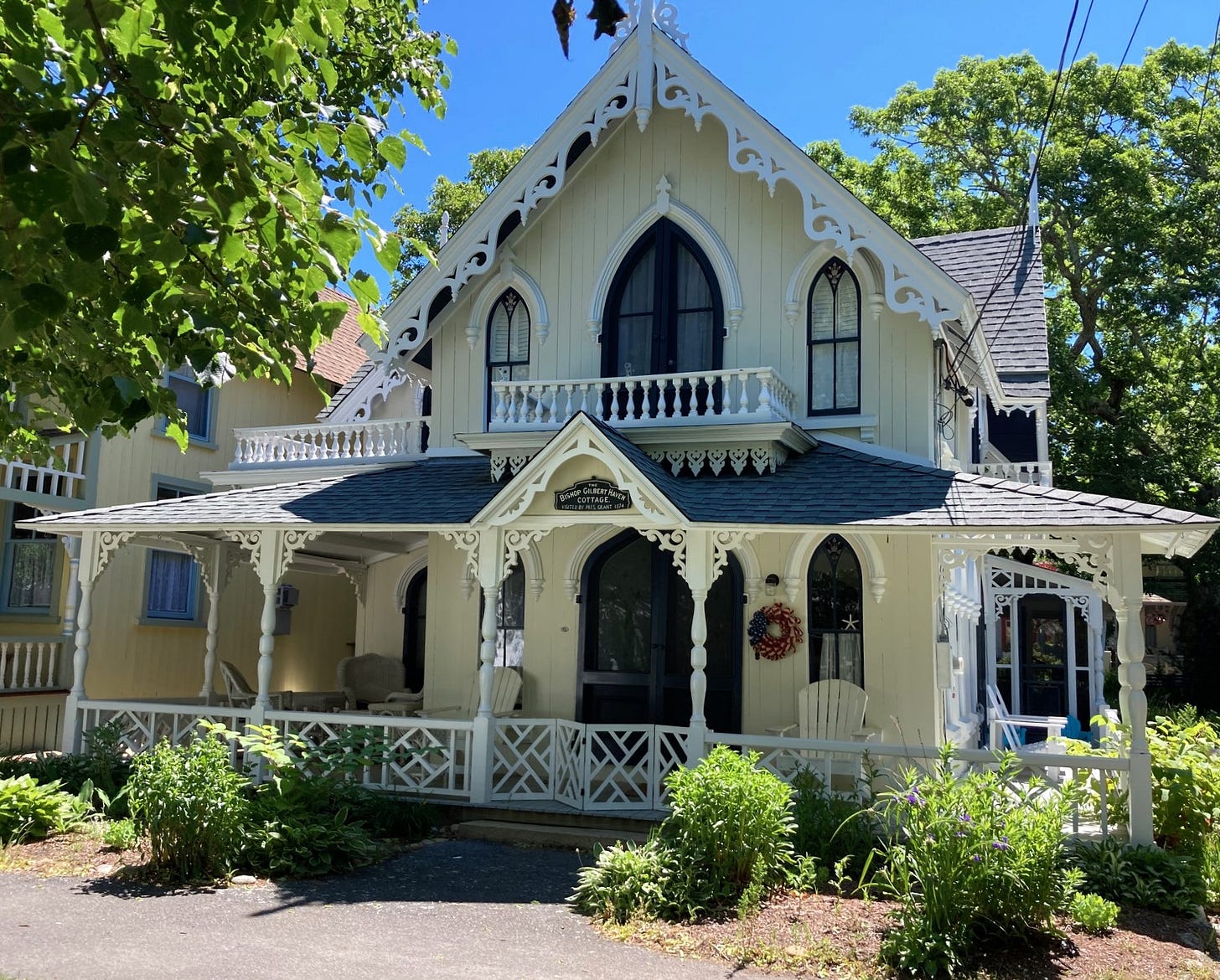
I did not expect to run into Ulysses S. Grant while vacationing on Martha’s Vineyard earlier this month.
Celebrity sightings are as much a given as overpriced coffee on the Vineyard (unless you caffeinate at Tony’s Market, which I highly recommend). Still, encountering the Civil War General/18th President of the United States took me by surprise.
My reaction has nothing to do with the fact that U.S. Grant died in 1885. It’s just that I was executive-branch weary after my recent Franklin Pierce obsession—to say nothing of the 2024 election cycle—and I needed and expected a mental break from all things presidential.
Other than reading a Martha Hall Kelly novel, the only remotely historical thing I planned on doing that week was meandering over to the Martha’s Vineyard Camp Meeting Association (MVCMA) Cottage Museum.
The “camp” part of “camp meeting” has nothing to do—at least, not these days—with setting up a tent in the wild so that you can get eaten by mosquitoes and lack access to indoor plumbing and thrash around miserably in your sleeping bag all night. In the early 19th century, a Protestant religious revival movement known as the Second Great Awakening caught fire out west—as in Kentucky and Indiana—and spread its way back east. Camp meetings were a popular aspect of this revival, allowing the far-flung faithful to converge outdoors for several days of preaching, praying, singing, and community. Think of these social and spiritual gatherings not as “my parents are dragging me to church on Sunday morning,” but as the Taylor Swift’s Eras tours of their times.
Nine tents were pitched for the first camp meeting on Martha’s Vineyard in 1835. By the mid-1850s, at least 200 tents had been erected in Wesleyan Grove. Each year, people arrived ever-sooner and stayed ever-later to relax and recreate before and after camp meetings. More permanent structures offering more privacy and comfort were needed. And so, in the late 1850s, cottages started replacing tents in the campground.
Sensing money-making opportunities, the Oak Bluffs Land and Wharf Company was established in 1866, ushering in an adjacent community of hotels, a carousel, a skating rink, sanctioned booze, and other secular amusements. All of this was located on the other side of the seven-foot fence the campground erected in 1869 to keep the ungodly out, and the godly in.
Thus began the rise of the summer vacation mecca that is now Martha’s Vineyard.
For most people, that is. Would you believe that freaking Nathaniel Hawthorne, who is underfoot everywhere I go these days, vacationed on Martha’s Vineyard decades before it was a thing? Yep, Hawthorne spent the summer of 1830 traipsing around cemeteries and bothering local craftspeople—”He was wont to sit and commune with a philosophical stone cutter,” wrote Henry Beetle Hough—and writing about it in his Twice-Told Tales.
But I digress. My specific reason for wanting to visit the MCVMA’s Cottage Museum was to find out how the Carpenter Gothic architectural style of “gingerbread” cottages had taken hold in the campground community.

That mystery was easily solved within the first hour of our arrival at the 1887 Northern Gothic style cottage we’d rented in East Chop, an Oak Bluffs neighborhood close to the MVCMA. Named in honor of the last heath hen ever seen, Booming Ben is not merely a well-located, charming house with every possible amenity, it’s a history lover’s dream.
While my husband unpacked and the kids made tracks for the beach, I admired the home’s arched windows and doors, then leafed through the vintage magazines and books. Pages 40-41 of A Centennial History of Cottage City answered my question.

Still, a couple of mornings later after finishing my $1.99 cup of Jamaican Me Crazy coffee from Tony’s, I figured I’d pop in and see what the Cottage Museum had to offer.
And I offer you: Nancy, and Ulysses S. Grant.
Nancy is the chatty, informative guide who I sense is already the stuff of legend within the MVCMA. Let’s just say she knows her cottages and who lived in which one when. She can definitely fill you in on the mini dramas roiling the community today, from who’s renting out their cottage more than the maximum six weeks annually allowed in the association’s bylaws to a contractor’s tool storage tent ruining the grass and disfiguring the quaintness of Clinton Avenue.

The tent, she pointed out, was in front of the cottage where President Grant stayed in August of 1874. Mementos of Grant’s visit abound in the Cottage Museum, and Nancy pointed out one that really had her curious: who were the people—one labeled “Mrs. Osbourne” in particular—in the Continental Quartette! who sang to Grant when he, Julia, and his political entourage were on Martha’s Vineyard? My presidential history brain was supposed to be on vacation, so I sailed past much of the memorabilia, listened with halfhearted interest to Nancy’s History Mystery, and attempted to forget that Grant had ever set foot on the island.
Obviously, that didn’t work out so well.
It kept niggling at me: why would Grant vacation on Martha’s Vineyard for only three days? Getting here in the 21st century isn’t easy: booking a Saturday crossing on a Woods Hole to Vineyard Haven or Oak Bluffs ferry less than three months out is nearly impossible. Travel was even more challenging then.
Grant, it turns out, was not interested in basking in the summer sun, or walking on the beach with a parasol-shielded Julia by his side. He wasn’t even there to get in touch with his spiritual side, despite being invited to the Vineyard by his pastor. No, Grant was there to suss out his chances of getting nominated for a third term.
“What?” you might be saying. “Wasn’t that guy a terrible president who surrounded himself with grifters? Why would he even think he had a chance at a third term?”
Because, in 1874, Grant was a national hero, as beloved and revered in his time as, say, Mother Teresa, Nelson Mandela, and Your Favorite Famous Person all rolled into one aloof, so-called “Six Star General” (one of only three in history). Just nine years before, Grant had accepted the surrender of Robert E. Lee’s Army of Northern Virginia, effectively ending the Civil War. The north won the war, so northerners were happy. The terms of surrender for southerners couldn’t have been more lenient—basically, “hoist your weapons on your shoulders, walk home, and don’t get into any more trouble, boys”—so southerners were, if not happy, at least relieved.
As a result, Grant was beloved by many and respected by pretty much all for how he’d performed as General of the Army. He’d been re-elected to a second term as president in 1872, so a majority of the citizens of the newly re-United States must’ve been happy enough with how things were going. Sure, there were rumblings about graft and corruption in his administration, but the Whiskey Ring bribery scandal didn’t break until May of 1875.
So, when General-turned-President Ulysses S. Grant docked in Oak Bluffs after a full day of travel on August 27, 1874, it was A Big Deal. Thousands of people crowded the mile or so route Grant’s horse-drawn carriage took to the cottage at 10 Clinton Ave. from the Highlands Wharf, which was built in 1871 so that “the Methodists wouldn’t have to disembark at the Oak Bluffs Wharf and pass through the temptations offered in that ‘unholy’ summer resort.” (The two wharves were spitting distance apart.)
The Grants were given about 1/2 hour to relax and refresh at the cottage, after which they: put in an appearance at the camp meeting’s Tabernacle; went to dinner with an entourage; viewed a Japanese lanterns display known as Illumination (still an integral part of camp life); viewed fireworks with an estimated 30,000 people; listened to a brass band; and went to a reception at their pastor’s cottage before returning to their cottage. Remember, they’d spent the entire morning and afternoon making the planes, trains, and automobiles—okay, steamships, trains, and ferries—trip to Martha’s Vineyard from New York City. They must’ve been freaking exhausted.

Which is why, when the aforementioned Continental Quartette! started serenading the president and his wife beneath their balcony, Grant reportedly said:
I thank you for your cheerful greeting. No doubt you are tired and sleepy, as I am, so I will not detain you. Good night.
Some would say this was rude, others have said Grant suffered from amusia, a condition where music simply sounds like noise, and the listener can’t distinguish one song from another. I say the poor man simply wanted to go to sleep already.
The next day was another round of dawn-to-midnight, nonstop travel on Nantucket and Cape Cod. Wouldn’t you know it, as soon as the Grants returned to 10 Clinton Avenue for their second night of attempting to get some sleep, the persistent Continental Quartette! apparated below their balcony.
According to Robert Lammey, the current occupant of 10 Clinton Avenue, Grant minced no words on Night #2.
Gentlemen, I suppose you are very tired, and we are. Good night.
Obviously, Grant was so sleepy he didn’t realize there were ladies in the quartette.
There are no reports of the Continental Quartette! returning on the third night. The Grants had spent the day meeting with supporters about whether Ulysses S. should throw his hat in the ring for a third term. Spoiler alert: he did not.
Grant did attend religious services at the camp meeting Tabernacle on the Sunday morning before he departed the island—from the saintly Highland Wharf, of course.
Where you’ll want to stay when you go to Martha’s Vineyard—specifically, Oak Bluffs—with a party or 8 or fewer people who can do steep staircases: https://www.booming-ben.com/
Resources
Hough, Henry Beetle. Martha’s Vineyard Summer Resort, 1835-1935. The Tuttle Publishing Company, 1936.
Stoddard, Chris. A Centennial History of Cottage City. Oak Bluffs Historical Commission, 1987.
https://mvmuseum.org/wp-content/uploads/2020/04/1987-C-Aug.pdf
https://www.masshist.org/object-of-the-month/objects/august-2022
https://www.salon.com/2022/12/24/the-true-story-of-the-couldnt-hear-music/
A Brighter Day Than This Never Dawned: President Grant’s 1874 Visit to MV. Presentation by Robert Lammey for the Martha’s Vineyard Museum. Originally offered on September 21, 2022, via Zoom.
Several visits to the Martha’s Vineyard Camp Meeting Association Cottage Museum between June 11-15, 2024. (Thank you, Nancy, Steve, and Doug).





Another winner! Your writing is both informative and amusing.
That was fascinating! I knew little about him before and nothing about the camp cottages!